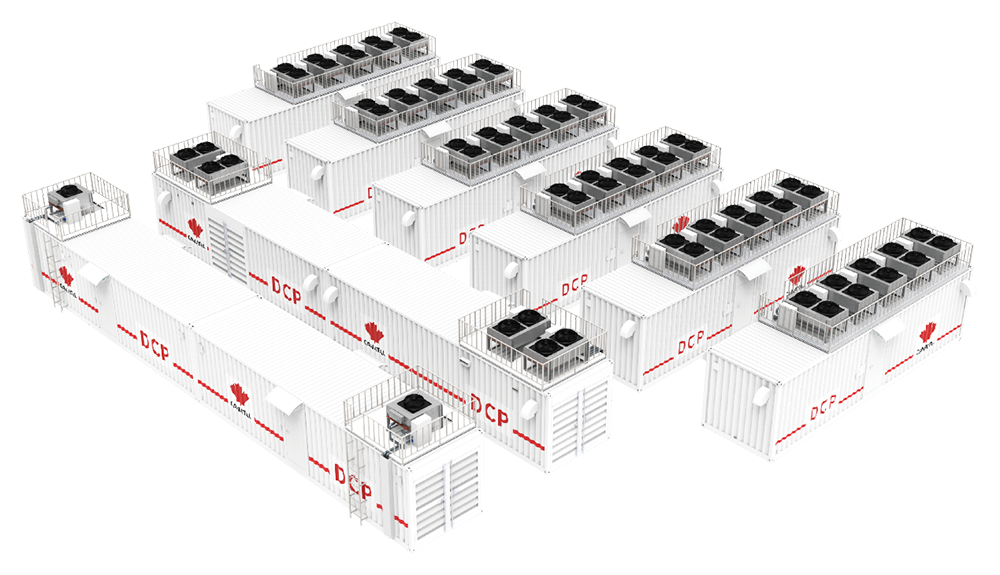Solutions
Distributed Computing Power Solutions
Solution Brief
Distributed computing units utilize shipping containers as computing centers, overcoming geographical limitations and aligning with energy strategies to form distributed computing clusters. These are managed, dynamically allocated, and scientifically scheduled via a cloud platform, representing an advanced, sustainable computing solution with significant market potential and future prospects.
This distributed computing solution employs an advanced modular design, dividing computing equipment into multiple small, distributed computing units. These units include power compartments, battery compartments, computing compartments, and cooling system compartments, all prefabricated in a factory. On-site installation requires only simple assembly and debugging before operation. The modular design facilitates assembly, maintenance, and upgrades, enhancing scalability and flexibility, allowing for rapid adjustment of computing capacity based on business needs. The power compartment features a 2N layout, integrating transformers, low-voltage switchgear, UPS units, and cooling air conditioners. Two battery compartments are included, using lead-acid batteries with a 15-minute backup time and equipped with cooling air conditioners and fire suppression systems. The computing compartment's IT configuration includes 10 IT cabinets, each with a capacity exceeding 20 kW. Container sizes are 40 feet and 45 feet, with customizable options available. This solution incorporates an intelligent management and maintenance system, using sensors and monitoring software to track equipment operation in real-time. Machine learning algorithms predict failures and optimize performance, enabling automated management and reduced maintenance costs. Furthermore, the computing site is equipped with a highly efficient cooling system to ensure stable temperatures during high-load operation, extending equipment lifespan.
Key Parameters
Computing power cabin dimensions: 12192 (length) * 3200 (width) * 3300 (height), 10 IT cabinets, single cabinet 23KW, EER≥3.5
Applicable Scenarios
1) Edge computing; 2) Emergency response and disaster recovery; 3) Exploration and offshore operations; 4) Military applications; 5) Educational and research institutions; 6) Temporary major events; 7) Carrier machine rooms; 8) Power three-station integration; 9) Smart transportation.
Advantageous Features
▪ Flexible and Convenient Deployment: (1) Flexible location selection; can be placed in remote areas, mines, near energy supply sites, temporary sites, etc.; (2) Rapid deployment. Servers, power distribution facilities, cooling systems, etc., can be integrated into the unit, prefabricated in the factory, and on-site installation can be completed in as little as 3-5 days.
▪ High Scalability: (1) Easy to increase computing power; when it is necessary to increase computing power, the number of distributed computing units can be increased to quickly expand capacity without large-scale transformation and upgrades; (2) The equipment layout inside the unit is compact, facilitating hardware upgrades.
▪ High Energy Efficiency: (1) Electricity is sourced locally; it can be deployed near energy supply sites to improve energy utilization efficiency; (2) Optimized heat dissipation; advanced heat dissipation technologies such as air cooling and water cooling are used; the container structure is conducive to the separation of hot and cold channels.
▪ High Reliability: (1) Redundant design; each unit is equipped with backup power, network, and cooling systems to ensure uninterrupted system operation; (2) Risk diversification; the distributed architecture distributes computing power to multiple units, and single-point failures or maintenance will not affect the operation of the entire system, improving system stability.
▪ Good Cost Effectiveness: (1) Low construction cost; the construction of containers does not require building a machine room, and the prefabricated production method also reduces costs; (2) Low operating costs; energy-saving, efficient, and reliable features can save a lot of electricity and maintenance costs. 



